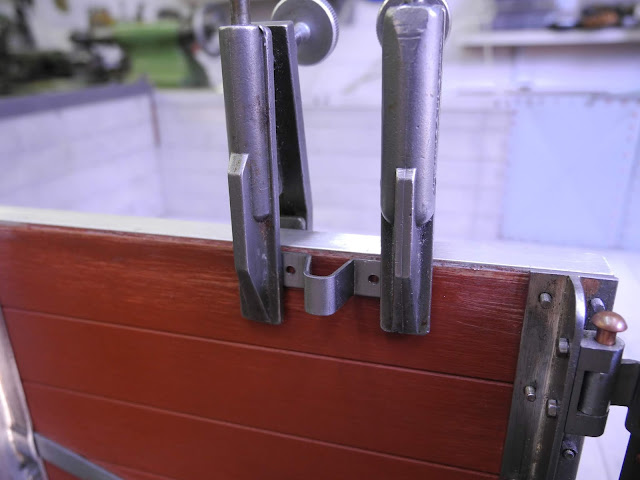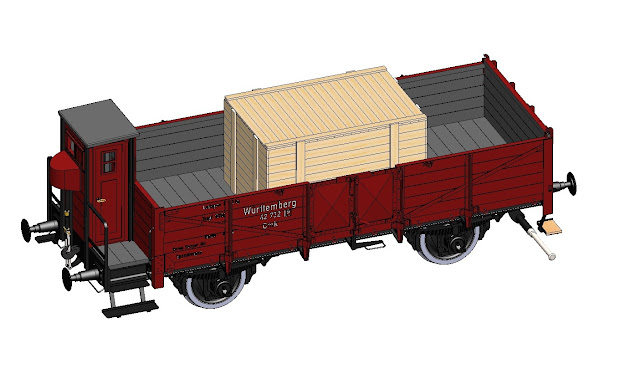Seat
A nice detail to make is the foldable seat inside the brakeman's cabin. This seat has a backrest that will fold up together with the seat. On the original drawings this is quite clearly drawn and is ingenious and at the same time a simple system.
Of course the seat has to be folded upward if the brakeman is entering the wagon from the right entrance. Otherwise the seat would be in the way to reach the brake handle. Although there is a seat, I think it was not very comfortable to sit there.
On a steel frame oak planks are screwed. The frame has the lugs for the folding mechanism.
In the upright position, the seat and backrest are sitting against the headboard.
A small stop on the other side of the cabin will hold the seat in the horizontal position.
In the folded down position it is clearly to see how the seat is blocking the entrance. Although it was nice to make, it won't be directly visible in the completed wagon.
Handbrake (parking brake)
As an extra this fork was made. This way the handbrake for the full scale engine driver can also be used as a parking brake. The part was milled and the radius is filed with filing buttons.
The fork is attached to the main shaft that operates the brake. It serves at the same time as an end limit for the movement of the brake handle that will be operated by the driver.
A tribute to Märklin. Their models got me into trains and model engineering in the first place.
Although in Solidworks the layout of this handbrake assembly could be designed, I worked in this case directly from the works drawings. Afterwards I've made the Solidworks drawing, to keep the drawing of my wagon up to date.
The brake spindle is attached to the back of the brakeman's cabin.
From solid brass the nut is milled and turned.
A separate nut is also made. The precise function I'm still not aware of. It is on the original drawing and looks like it has to act as a limiter to the end of the stroke of the spindle.
The complete brake spindle on its own subframe.
To determine the exact position on the wagon, the bufferbeam is removed and clamped to the brakeman's cabin.
These levers connect the brake spindle to the brake gear.
The complete assembly.
The hand lever inside the brakeman's cabin.
Doorstops
These little items act as an end stop for the side doors.
To bend these stops, a small bending punch was milled from brass.
Operated in the vice of the milling machine, the strips were quickly bend into shape.
These items are too small to bend in this shape on my bending machine.
A set-up on the milling machine, the positions for the holes were centered.
Holding them in place with small clamps, prior for drilling.
The stop, preventing the doors slapping against the side boards.
The door catch below the door was made in a similar way.
The complete wagon
A few of the models I've used to make this open goods wagon / driving truck.
Ranging from gauge N, H0 and gauge 0.
The book of Güterwagen Band 3, shows that the model firms do not always work exact to scale and not all wagons that are available on the market are correct.
So if you find any mistakes or omissions in my wagon I'm in line with the great names as Märklin, Fleischmann, etc. 😀
Box
For the driver (this wagon will be the driving truck for my steam loco) a seat is also needed.
This wooden box doubles as a seat and storage box.
It is a simple wooden box, made of 9mm multiplex and it is cladded with 4 x18 mm pine wood slats.
Some kind of logo of manufacturer will be put on the sides, so it will have the appearance of a real wagon load.
Next step is painting and lettering the wagon.









































































